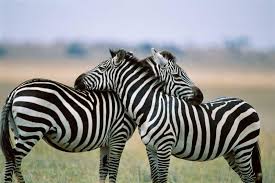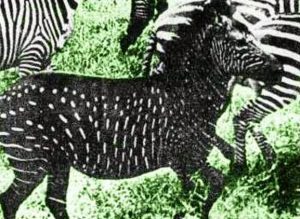Podcast: Play in new window | Download (Duration: 9:18 — 11.2MB)
This week let’s learn about some astonishing giraffes and zebras that don’t look like you’d expect!
Further reading:
See the Rare, Spotless Giraffe Born at a Tennessee Zoo
Giraffe Conservation Foundation
A tale of two zebras: South African photos used in misleading posts about Kenya’s polka-dot foal
Zebra News: Spotted Tira, Zonkeys and Zorses
Further viewing:
The Mysterious Return of Tira the Spotted Dark Zebra in Masai Mara
Kipekee the spotless giraffe [pic is from the first link posted above]:
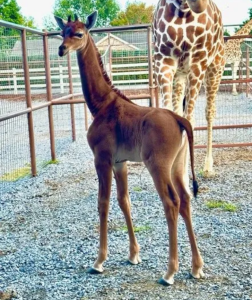
The picture posted on Facebook by Giraffe Conservation Foundation on Sept. 10, 2023:
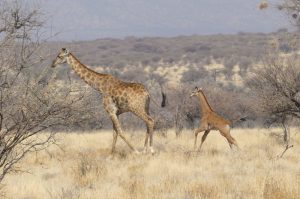
Tira the spotted zebra as a baby in 2019:
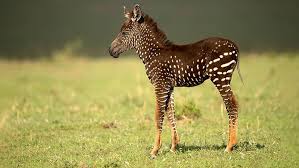
Tira the spotted zebra is getting so grown up (or was in 2021)!
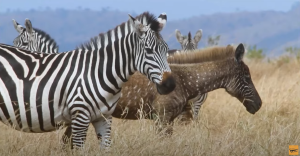
A DIFFERENT spotted zebra from South Africa:
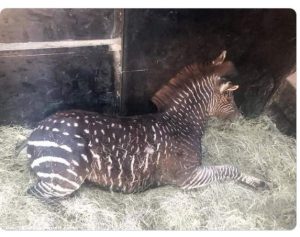
Show transcript:
Welcome to Strange Animals Podcast. I’m your host, Kate Shaw.
I’m back from Dragon Con, where I had a great time as usual! I was careful and wore a mask while I was around other people, but masking works best when everyone wears a mask, which as we all know doesn’t happen very often right now. Luckily I didn’t get covid, but I did come down with an ordinary cold. I’m just about over it now, though, so hopefully I don’t sound too bad.
I live in Tennessee, and before I left for Dragon Con I kept seeing news reports about an unusual baby giraffe born in a Tennessee zoo. You may have heard about the giraffe calf too. As you probably know, giraffes have an elaborate pattern of markings called spots, although they’re not spots like a leopard’s spots. They look a lot like the cracks in a dried-up mudpuddle, where the muddy parts are dark brown or orangey-brown, and the cracks in between are tan or white. It’s sometimes called a web pattern, where the lighter design looks like a web overlaid on a darker coat.
Whatever you call it, all giraffes have these markings. But on July 31, 2023, a calf was born that didn’t have any spots at all. She’s completely brown. Also, very beautiful and cute as a little button.
The calf was born at Brights Zoo, which is near a community called Limestone in Tennessee. I’d never heard of the zoo, so I assumed it was in middle or west Tennessee, and I live in east Tennessee. But when I looked it up, it’s actually quite close to me. I will definitely be visiting as soon as I get a chance! (Its website says Google Maps has its address wrong, by the way, in case you plan to visit it too.) It’s a private zoo dedicated to education and conservation, and among the animals they care for are giraffes.
The calf in question is an endangered reticulated giraffe. Conservationists estimate that fewer than 9,000 reticulated giraffes remain in the wild these days, but it does well in captivity and is a popular animal in zoos. The reticulated giraffe was once common throughout northeast Africa, although its range is fractured into little areas now. It’s happy in a number of habitats, including rainforests and savannas.
The zoo came up with four name choices for their calf and invited people to vote for which name they liked best. The winning name was announced just a few days ago as this episode goes live, Kipekee. It means “unique” in Swahili, the official language of Kenya.
Kipekee is healthy and active, and the zoo reports she was immediately accepted by her mother and all the other giraffes as just a regular baby. I guess giraffes understand that what you look like isn’t nearly as important as how you act, and Kipekee acts like a curious little baby giraffe.
In a lot of news reports, you’ll hear that Kipekee is the only unspotted giraffe seen since 1972, when one was born in a zoo in Japan, and that she’s likely the only unspotted giraffe alive in the entire world right now. But then, only a matter of hours before this episode goes live, because I took forever to start working on it, the Giraffe Conservation Foundation dropped a post on their Facebook page. It has a photo of a giraffe mama and baby running along in the wild in Namibia in Africa. And the baby giraffe HAS NO SPOTS!
As of right now, that’s all we know about the other spotless giraffe calf, but I’ll definitely keep you posted in future episodes.
Speaking of updates, reading about the giraffe without spots reminded me of an episode we released at the end of 2019, about Tira the zebra. Instead of stripes like ordinary zebras, Tira had spots!
Tira was first observed by a tour guide in Kenya in September of 2019. The guide’s name is Antony Tira and the foal was named after him. Little Tira was just a baby back then, living with her herd on a national reserve.
But then, according to internet rumor, something awful happened. Little Tira and her mom were captured, put on a truck to smuggle them out of the reserve, and sold to a private collector! There were even pictures of the pair in a truck. And sure enough, Tira was nowhere to be found in the wild.
But things aren’t always what they seem, especially on the internet. Because amazingly, just like little Kipekee being born at about the same time as another super-rare spotless giraffe, little Tira was born at about the same time as another spotted zebra. The second foal was a boy who was observed in South Africa. But unlike Tira, who was safely in protected land, the second foal wasn’t so lucky. A veterinarian named Craig Bull was hired to relocate the mother and baby to a safer location, which he did with the help of his team. People saw pictures of a spotted zebra baby and its mother in a truck and jumped to the wrong conclusions.
Zebras are famous for their black and white stripes, but on very rare occasions, a genetic mutation causes the ordinary striped pattern to be broken up so that it looks like spots. Most people think zebras are white animals with black stripes, but that’s actually backwards. Zebras are black with white stripes, so when the stripe pattern is broken up, the zebra looks like a black or brown animal with white spots and streaks. Every zebra’s pattern is unique, just as every giraffe’s spot pattern is unique, so a close look at the photo of the spotted zebra in a truck shows it’s obviously not the same animal as Tira. Their spot patterns are totally different.
So what did happen to Tira? Why did she disappear? Is she even still alive?
On September 29, 2019, when Tira was probably only a few weeks old, a wildlife photographer spotted her crossing the Sand River into Serengeti Park in Tanzania with her herd. Zebra herds migrate to new pastures periodically, along with other animals like wildebeest, so that wasn’t unusual. But because life in the wild is hard for young animals, no one was really surprised when Tira wasn’t seen again.
At least, she wasn’t seen again until August of 2021, when a tour guide and photographer pair saw her in the middle of the herd. She had grown to the size of a typical two-year-old filly and looked healthy. As is common in zebras, she was still with her mother and still nursing occasionally.
That’s all we know now, but if Tira survived for two years, she’ll probably be just fine. She would be four years old now, basically a young mare, and she might even have a baby of her own by now. Hopefully some lucky photographer will see her again soon and give us an update on everyone’s favorite spotted zebra.
You can find Strange Animals Podcast at strangeanimalspodcast.blubrry.net. That’s blueberry without any E’s. If you have questions, comments, or suggestions for future episodes, email us at strangeanimalspodcast@gmail.com. We also have a Patreon at patreon.com/strangeanimalspodcast if you’d like to support us for as little as one dollar a month and get monthly bonus episodes.
Thanks for listening!
